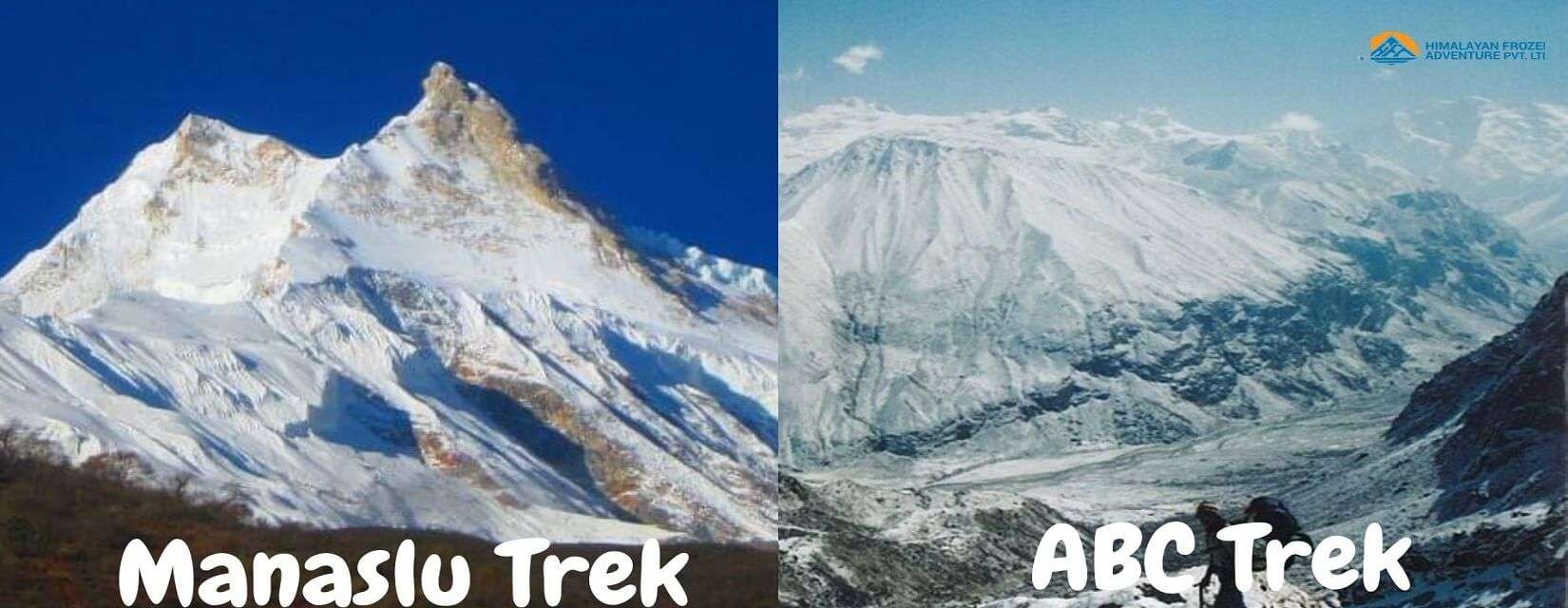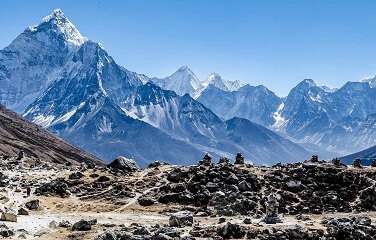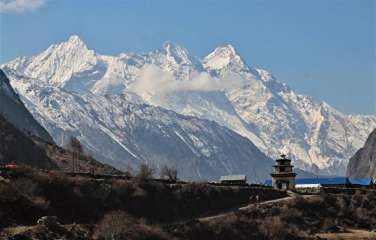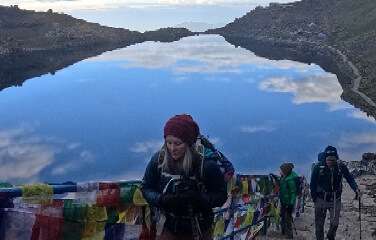Importance of choosing the right trek

The difficulty, altitude, and terrain of treks vary, so you should pick your trek carefully. Your safety is the most crucial thing to consider. Your trek must be appropriate for your level of fitness, experience, and abilities.
Your entertainment should come in second on your priority list after safety. To have the experiences you want, you must pick treks that fit your interests, preferences, and goals. Before choosing the trek, consider what appeals to you the most: expansive mountain views, exposure to culture, or unexplored wilderness.
Select a trek that is in line with your objectives, aspirations, and unique challenges if you want to find personal fulfillment. The satisfaction can come from completing a particular mountain pass, getting to a specific location, or traveling a special cultural path. If you're trekking with others, pick a route that takes into account everyone's skills and goals.
Annapurna Base Camp Trek

Mount. At 26,545 feet above sea level, Annapurna ranks as the tenth-highest mountain in the entire world. An alp in the Himalayas in northern Nepal called Annapurna has one peak that is over 26000 feet, thirteen that is over 23000 feet, and sixteen that are over 20000 feet. The Marshyangdi River on the northeast, the Pokhara Valley on the south, and the Kali Gandaki Gorge on the west all encircle the entire massif. Due to its isolation from both road and air travel, the Annapurna Base Camp Trekking Trail is one of the best options for hikers and trekkers.
It is one of the lowest 8000-meter mountain base camps, and it is located 4200 meters above sea level. When compared to other 8000-meter mountain base camps, the Annapurna trek is simpler because it is close to Pokhara city, less congested, and filled with wildlife, culture, and natural beauty. One of the most beautiful panoramic views in the world can be seen from Ghorepani Poonhill, where you must turn both right and left to see the entire Annapurna Mountain range. Thus, it is also known as the world's largest eyeful.
How difficult is it to trek to the Annapurna Base Camp?
After Everest Base Camp, Annapurna Base Camp is located at a height of 4130 meters, and this trek route is one of the most well-known and picturesque trekking routes in Nepal. Both experienced and novice trekkers enjoy this trek equally.
The Annapurna Base Camp trek is not regarded as being a challenging trek because it is very adventurous and requires slow, steady walking. Therefore, this trek is regarded as moderate. The Everest Base Camp Trek is just as challenging and beautiful, but it is also very enjoyable and doable with a little bit of patience.
Every step of your walk through the Mountain while trekking or hiking could hold a surprise adventure. For hikers and adventure travelers, the trek to Annapurna Base Camp is also a very thrilling and adventurous journey, and the challenges and difficulties will increase until we reach our destination.
Duration of the Annapurna Base Camp Trek

Normally, the Annapurna Base Camp Trek takes two weeks to complete, but if you move quickly, you can finish it in just nine days. The length of the trek can be increased or decreased to suit your needs, and the Annapurna Base Camp trek itinerary can vary depending on the various packages created by various travel and trekking companies.
During your adventure trek to Annapurna Base Camp, you must walk for an average of 5 to 6 hours per day. If you don't make it a habit to walk, it will take you 7-8 hours to get there, which could cause you problems and grief.
In order to prevent this from happening and to strengthen your walking ability, you should walk far distances and up and down hills. You should also establish a hiking schedule for a few months prior to beginning your adventure hike to Annapurna Base Camp. Start by working on your legs and your body will develop the habit of walking, which will help you during your adventure hike. You can take full advantage of this ABC Trek.
Permit and costs
You need an Annapurna Conservation Area Permit (ACAP) to walk to Annapurna Base Camp (ABC) in Nepal. Each person must purchase an Annapurna Conservation Area Permit (ACAP) for USD 30. Citizens of SAARC can purchase this permit for Rs. 2000. You also require a TIMS (Trekkers' Information Management Systems) card in addition to the ACAP. A TIMS card costs NPR 1,000 for SAARC (South Asian Association for Regional Cooperation) members and NPR 2,000 for everyone else.
Manaslu Circuit Trek

East of the Annapurna range in Nepal's Gorkha district is where you'll find the Manaslu region. It is home to Mount Manaslu, the eighth-highest peak in the world at 8,163 meters above sea level. Manasa means "intellect" or "soul" in Sanskrit. The Japanese team first scaled Manaslu in 1956 after numerous failed attempts. The Manaslu Conservation Area safeguards the entire area. This 1,663 sq km (642 sq mi) conservation area was created in 1998.
From Soti Khola to Dharapani, the Manaslu Circuit Trek circles Mount Manaslu, nearly completing the circle in 13 to 17 days. The lower region of the circumference is where we cross the subtropical Himalayan foothills and enter the alpine aird landscape, providing a completely different view. Only experienced trekkers had access to this restricted trekking area of Nepal for many years because it was always a camping trek. But now that the Manaslu Trek is a tea house trekking route, it has gained worldwide recognition.
Manaslu Circuit Trek Itinerary
Day 1: Drive from Kathmandu to Soti Khola (710m)
Day 2: Trek from Soti Khola to Machha Khola (900 m)
Day 3: Trek from Machha Khola to Jagat (1340 m)
Day 4: Trek from Jagat to Deng (Dyang) (1860 m)
Day 5: Trek from Deng to Namrung (2660 m)
Day 6: Trek from Namrung to Sama Gaun (3220 m)
Day 7: Acclimatization Day at Sama Gaun (3220 m)
Day 8: Trek from Sama Gaun to Samdo (3860 m)
Day 9: Rest Day at Samdo (3860 m) (Acclimatization Hike to Tibet Border)
Day 10: Trek from Samdo to Dharamasala (4480 m)
Day 11: Trek from Dharamasala to Bhimtang (3750 m) via Larke Pass (5160 m)
Day 12: Trek from Bhimtang to Gho (2550 m)
Day 13: Trek from Gho to Dharapani (1910 m)
Day 14: Drive from Dharapani to Beshisahar to Kathmandu
Permit and costs
To trek in the Manaslu region, you need to obtain a special permit known as the Manaslu Restricted Area Permit (RAP) and the Annapurna Conservation Area Permit (ACAP). Here is an overview of the permits and their costs:
Manaslu Restricted Area Permit (RAP):
- For September to November: USD 100 per person for the first week and USD 15 per day thereafter.
- For December to August: USD 75 per person for the first week and USD 10 per day thereafter.
- The permit is valid for a maximum of 30 days.
Annapurna Conservation Area Permit (ACAP)
- USD 30 per person. SAARC citizens will get this permit for Rs.2000
These permit costs may change in the future. Normally, your trek and tour company will acquire these permits on your behalf.
The difficulty level of the trek

The Manaslu Circuit Trek is a difficult trek that is best suited for hikers in good physical condition. If you've been on a trek before, that will be very helpful. On a trail with steep ascents and descents on rocky and occasionally unstable terrain, the trek requires long walking hours. Trekkers must negotiate exposed, congested trails, cross suspension bridges, and contend with adverse weather. An issue on the Manaslu Circuit Trek is altitude sickness. A gradual ascent and adequate acclimatization are essential for reducing the risk of altitude-related illnesses.
Accommodation and food
The Annapurna Base Camp trek and the Manaslu Circuit have different lodging and dining options. There are few accommodations along the Manaslu Circuit because of its isolation and underdeveloped location. In villages, you can find tea houses and lodges that offer simple amenities like shared rooms and communal dining areas. Local dishes like dal bhat (rice and lentil soup), noodles, potatoes, and seasonal vegetables make up the majority of the menu options.
The route is more well-known and well-established on the Annapurna Base Camp Trek, providing a wider variety of lodging options. Nearly every village along the trail has tea houses and lodges that offer dining options in addition to private or shared rooms. The menu options are more varied and include both regional Nepali cuisine and international cuisine. Pasta, pizza, momo (dumplings), and other foods are frequently found on these menus. However, keep in mind that along both treks, different tea houses and lodges may offer different levels of comfort and culinary variety.
Cultural experience
The Manaslu Circuit leads you through the isolated area surrounding Mount Manaslu, where you'll come across communities with a strong Tibetan influence, like the Gurungs, Nubri, and Tsum people. Your cultural experience is enriched by learning about their distinctive customs, languages, and religious beliefs, such as Buddhism. On the other hand, you'll come across numerous ethnic groups, including Gurungs, Magars, Thakalis, and others, during the Annapurna Base Camp Trek, each with its own distinctive cultural practices and languages.
On each trek, you will experience a different set of cultural rituals and celebrations. You might see locals performing customary ceremonies and rituals along the Manaslu Circuit during celebrations like Losar (the Tibetan New Year) and Dumje. During festivals like Dashain and Tihar in the autumn, you might have the chance to see cultural dances, music, and celebrations while hiking to Annapurna Base Camp.
Which Trek to Choose?

Depending on your preferences and priorities, you may want to choose between the Manaslu Circuit and the Annapurna Base Camp treks. The Manaslu Circuit trek is a fantastic option if you're looking for a more secluded and less congested experience with a focus on cultural immersion and difficult terrain. It offers breathtaking mountain vistas, villages with Tibetan influences, and the excitement of ascending steep mountain passes.
The Annapurna Base Camp trek is the best option if you prefer a well-known and well-liked trek with a variety of landscapes, easier accessibility, and a lively trail community. It offers breathtaking views of the Annapurna massif, quaint villages, and the chance to interact with other hikers. Both treks, in the end, offer distinctive experiences, so pick your trek carefully and take into account your preferences for remoteness, cultural immersion, difficulty, and trail popularity.
Himalayan Frozen Adventure, a reputable trek and tour operator, offers numerous treks to Annapurna Base Camp and the Manaslu Circuit. Simply contact us by phone at +977- 9840396708, via WhatsApp, or email at [email protected].





